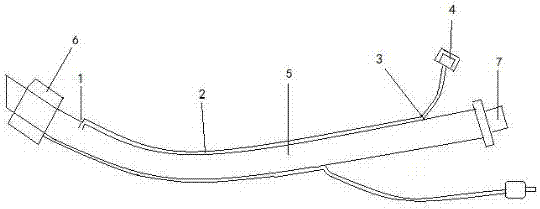Tracheal catheter capable of directly monitoring end-tidal carbon dioxide partial pressure of infant
A technology of carbon dioxide and endotracheal tubes, which is applied in the direction of tracheal intubation, respirators, and evaluation of respiratory organs, etc., can solve problems such as inaccurate monitoring, hidden dangers of respiratory management in children, and obvious carbon dioxide dilution, and achieve simple structure and improved monitoring Accuracy, use effect is remarkable
- Summary
- Abstract
- Description
- Claims
- Application Information
AI Technical Summary
Problems solved by technology
Method used
Image
Examples
Embodiment 1
[0023] An opening 1 is set at a distance of 1 cm from the cuff 6 on the catheter 5 , that is, a sampling point, and the breathing gas entering the beginning of the catheter 5 is collected. The opening 1 is connected to the thin tube 2, which is a thin tube 2 with an inner diameter of 0.5 mm. The thin tube 2 is connected to the wall of the endotracheal catheter. The catheter is outside the patient's body and is separated from the catheter 5. The end of the thin tube 2 is a threaded port 4, and the threaded port 4 is connected to an end-tidal carbon dioxide monitor. The gas breathed by infants and young children is collected at the opening 1 of the catheter 5 and passed through the thin tube 2. Because the sampling site is close to the top of the trachea, it is less affected by the fresh air flow, and can accurately reflect the end-tidal carbon dioxide level, and the use effect is remarkable. Connector 7 is connected to the ventilator.
Embodiment 2
[0025] An opening 1 is set at a distance of 1.5 cm from the cuff 6 on the catheter 5 , that is, a sampling point, and the breathing gas entering the beginning of the catheter 5 is collected. The opening 1 is connected to the thin tube 2, which is a thin tube 2 with an inner diameter of 1 mm, and the thin tube 2 is connected to the wall of the endotracheal tube. The catheter is outside the patient's body and is separated from the catheter 5. The end of the thin tube 2 is a threaded port 4, and the threaded port 4 is connected to an end-tidal carbon dioxide monitor. The gas breathed by infants and young children is collected at the opening 1 of the catheter 5 and passed through the thin tube 2. Because the sampling site is close to the top of the trachea, it is less affected by the fresh air flow, and can accurately reflect the end-tidal carbon dioxide level, and the use effect is remarkable. Connector 7 is connected to the ventilator.
Embodiment 3
[0027] An opening 1, ie a sampling point, is set at 2 cm away from the cuff 6 on the catheter 5 to collect the breathing gas entering the beginning of the catheter 5 . The opening 1 is connected to the thin tube 2, which is a thin tube 2 with an inner diameter of 1.2mm. The thin tube 2 is connected to the wall of the endotracheal catheter. The catheter is outside the patient's body and is separated from the catheter 5. The end of the thin tube 2 is a threaded port 4, and the threaded port 4 is connected to an end-tidal carbon dioxide monitor. The gas breathed by infants and young children is collected at the opening 1 of the catheter 5 and passed through the thin tube 2. Because the sampling site is close to the top of the trachea, it is less affected by the fresh air flow, and can accurately reflect the end-tidal carbon dioxide level, and the use effect is remarkable. Connector 7 is connected to the ventilator.
[0028] The tracheal tube provided by the present invention is ...
PUM
| Property | Measurement | Unit |
|---|---|---|
| The inside diameter of | aaaaa | aaaaa |
| The inside diameter of | aaaaa | aaaaa |
Abstract
Description
Claims
Application Information
 Login to View More
Login to View More - R&D
- Intellectual Property
- Life Sciences
- Materials
- Tech Scout
- Unparalleled Data Quality
- Higher Quality Content
- 60% Fewer Hallucinations
Browse by: Latest US Patents, China's latest patents, Technical Efficacy Thesaurus, Application Domain, Technology Topic, Popular Technical Reports.
© 2025 PatSnap. All rights reserved.Legal|Privacy policy|Modern Slavery Act Transparency Statement|Sitemap|About US| Contact US: help@patsnap.com

